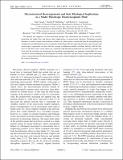Microstructural Rearrangements and their Rheological Implications in a Model Thixotropic Elastoviscoplastic Fluid
Author(s)
Jamali, Seyedsafa; McKinley, Gareth H; Armstrong, Robert C
DownloadPhysRevLett.118.048003.pdf (2.964Mb)
PUBLISHER_POLICY
Publisher Policy
Article is made available in accordance with the publisher's policy and may be subject to US copyright law. Please refer to the publisher's site for terms of use.
Terms of use
Metadata
Show full item recordAbstract
We identify the sequence of microstructural changes that characterize the evolution of an attractive particulate gel under flow and discuss their implications on macroscopic rheology. Dissipative particle dynamics is used to monitor shear-driven evolution of a fabric tensor constructed from the ensemble spatial configuration of individual attractive constituents within the gel. By decomposing this tensor into isotropic and nonisotropic components we show that the average coordination number correlates directly with the flow curve of the shear stress versus shear rate, consistent with theoretical predictions for attractive systems. We show that the evolution in nonisotropic local particle rearrangements are primarily responsible for stress overshoots (strain-hardening) at the inception of steady shear flow and also lead, at larger times and longer scales, to microstructural localization phenomena such as shear banding flow-induced structure formation in the vorticity direction.
Date issued
2017-01Department
Massachusetts Institute of Technology. Department of Chemical Engineering; Massachusetts Institute of Technology. Department of Mechanical EngineeringJournal
Physical Review Letters
Publisher
American Physical Society
Citation
Jamali, Safa, Gareth H. McKinley, and Robert C. Armstrong. “Microstructural Rearrangements and Their Rheological Implications in a Model Thixotropic
Elastoviscoplastic Fluid.” Physical Review Letters 118.4 (2017): n. pag. © 2017 American Physical Society.
Version: Final published version
ISSN
0031-9007
1079-7114